

As you can see below, blogging is a method of communication that can heighten an event with the energy of the text and images. Clearly this being the first launch ever of Boeing’s Starliner transporting NASA’s astronauts Butch and Suni is historical.
The following is the account today of the preparation underway for the first Boeing Starliner transporting humans to the International Space Station.

Update: ULA Atlas V launch of Boeing’s Starliner NASA astronauts mission progresses
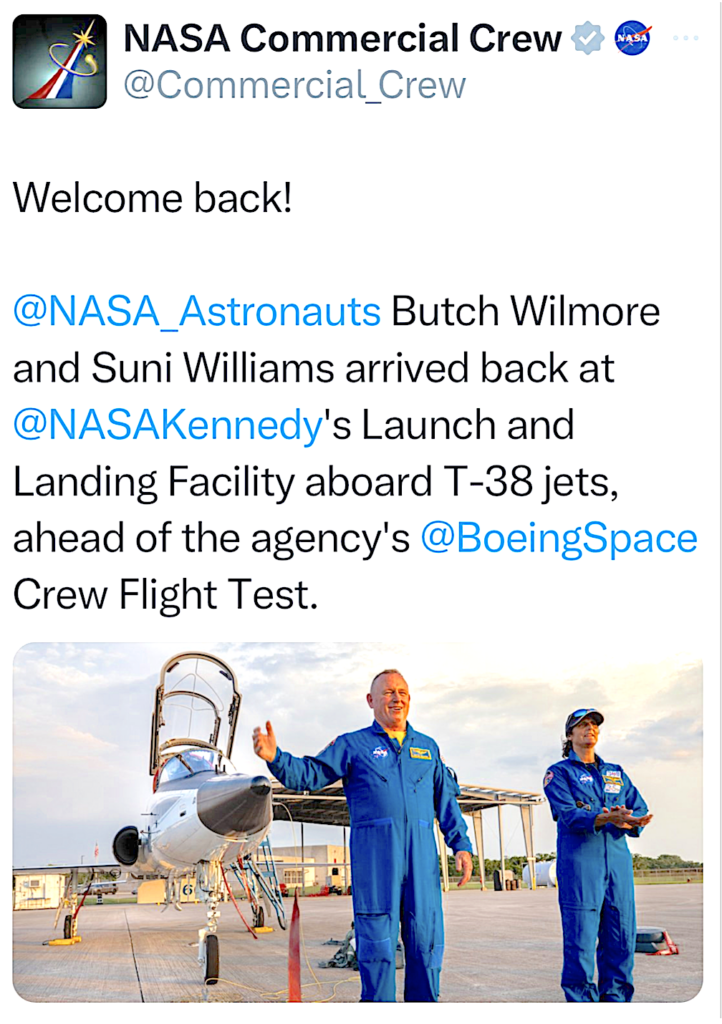
Everything continues to progress towards the ULA Atlas V launch carrying the first crewed Boeing Starliner spacecraft for NASA’s Commercial Crew Program (CCP). The mission is planned to lift off on Saturday, June 1 from Space Launch Complex-41 at Cape Canaveral Space Force Station in Florida. The launch is planned for 12:25 p.m. EDT. Today’s forecast shows a 90 percent chance of favorable weather conditions for launch.
NASA and Boeing teams polled “go” to proceed with plans to launch the agency’s Boeing Crew Flight Test to the International Space Station at 12:25 p.m. EDT Saturday, June 1. During a Delta-Agency Flight Test Readiness Review Wednesday at NASA’s Kennedy Space Center in Florida, leaders from NASA, Boeing, and ULA (United Launch Alliance) verified launch readiness, including all systems, facilities, and teams supporting the test flight.
A backup launch opportunity is available on Sunday, June 2, with additional launch windows on Wednesday, June 5, and Thursday, June 6.
NASA astronauts Butch Wilmore and Suni Williams returned to Kennedy on May 28, and will remain in quarantine at the Neil A. Armstrong Operations and Checkout Building until Saturday’s launch. The crew previously quarantined in Houston while mission teams worked to resolve various items with the rocket and spacecraft since scrubbing an initial launch attempt on May 6.
Next up, NASA leaders, along with Boeing and ULA partners, will hold a prelaunch news conference at 1 p.m. EDT Friday, May 31, at Kennedy’s press auditorium.
Liftoff of the Atlas V rocket and Starliner spacecraft will occur from Space Launch Complex-41 at Cape Canaveral Space Force Station in Florida. The Crew Flight Test will send Wilmore and Williams to the orbiting laboratory for about a week before returning to Earth aboard the reusable crew capsule, which will make a parachute- and- airbag-assisted landing in the southwestern United States.
UPDATE ULA announces repairs done and date of NASA and Boeing’s Starliner astronauts launch

Managers from NASA, Boeing, and ULA (United Launch Alliance) hosted a media teleconference to discuss ongoing work ahead of sending NASA astronauts Butch Wilmore and Suni Williams to the International Space Station as part of the agency’s Boeing Crew Flight Test.
The media event provided an update on a valve ULA replaced on the Centaur upper stage of the Atlas V rocket, as well as a small helium leak in the spacecraft’s service module, and a propulsion system assessment to understand potential helium system impacts on some Starliner return scenarios.
Listen to a replay of the media teleconference on the agency’s YouTube channel.
Wilmore and Williams are the first to launch aboard Boeing’s Starliner on an Atlas V rocket. The astronauts will spend about a week at the orbiting laboratory before the crew capsule makes a parachute and airbag-assisted landing in the southwestern United States.
The crew remains in quarantine in preparation for the launch. NASA, Boeing, and ULA also will participate in a Delta-Agency Flight Test Readiness Review on Wednesday, May 29, to evaluate the work performed since the last launch attempt on May 6.
Liftoff is scheduled for 12:25 p.m. Saturday, June 1, from Space Launch Complex-41 at Cape Canaveral Space Force Station in Florida. After successful completion of the flight test, NASA will begin the final process of certifying Starliner and its systems for crewed rotation missions to the space station.
Boeing’s update regarding delay of ULA’s launch of NASA’s Starliner

Starliner docks to the ISS for the first time on OFT-2. (NASA photo)
Following is a report from Boeing:
NASA, Boeing, and ULA (United Launch Alliance) teams continue working remaining open tasks in preparation for the agency’s Boeing Crew Flight Test to the International Space Station. The teams now are targeting a launch date of no earlier than 4:43 p.m. EDT on Tuesday, May 21, to complete additional testing.
On May 11, the ULA team successfully replaced a pressure regulation valve on the liquid oxygen tank on the Atlas V rocket’s Centaur upper stage. The team also performed re-pressurization and system purges, and tested the new valve, which performed normally.
Starliner teams are working to resolve a small helium leak detected in the spacecraft’s service module traced to a flange on a single reaction control system thruster. Helium is used in spacecraft thruster systems to allow the thrusters to fire and is not combustible or toxic.
NASA and Boeing are developing spacecraft testing and operational solutions to address the issue. As a part of the testing, Boeing will bring the propulsion system up to flight pressurization just as it does prior to launch, and then allow the helium system to vent naturally to validate existing data and strengthen flight rationale. Mission teams also completed a thorough review of the data from the May 6 launch attempt and are not tracking any other issues.
The Atlas V and Starliner remain in the Vertical Integration Facility at Space Launch Complex-41 on Cape Canaveral Space Force Station in Florida.
NASA astronauts Butch Wilmore and Suni Williams, still in preflight quarantine, returned to Houston on May 10 to spend extra time with their families as prelaunch operations progress. The duo will fly back to NASA’s Kennedy Space Center in Florida in the coming days.
ULA’s Boeing Starliner launch for NASA astronauts delayed again adding to the $1.5 billion over budget

An Atlas V N22 rocket will launch Boeing’s Starliner on CFT. Photo by United Launch Alliance
Starliner’s mission carrying two NASA astronauts had been scheduled for liftoff from Florida last week until a technical issue with its Atlas 5 rocket prompted a delay to Friday, May 17. The launch of Starliner is now set for no earlier than 4:43 p.m. Tuesday, May 21 at 4:43 p.m. The astronauts, Butch Wilmore and Suni Williams, reportedly returned to Houston to be with their families and now plan to return to Florida in the coming days
This hitch in the latest postponement only compounds the expense for a program years behind schedule and more than $1.5 billion over budget.
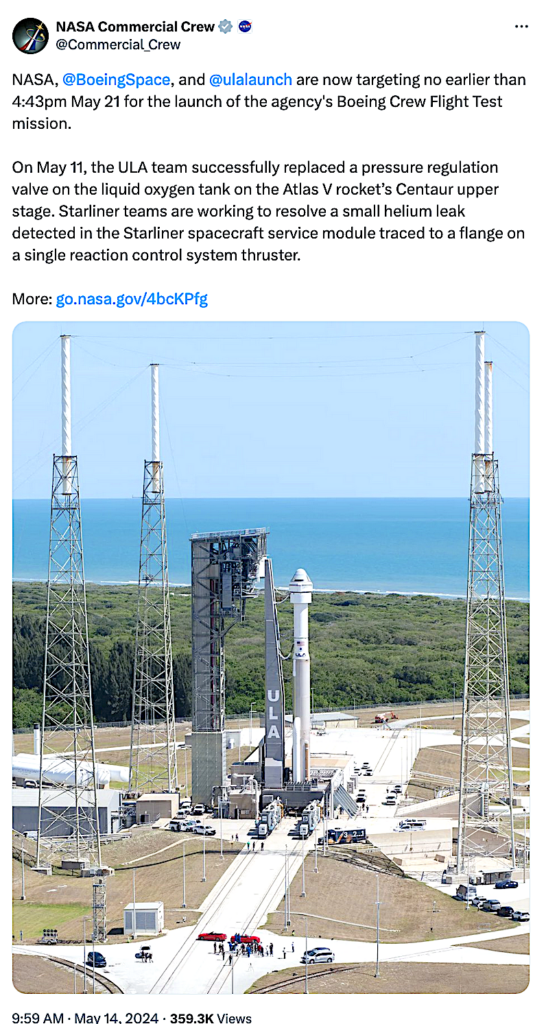
Boeing stated that a small helium leak was detected in the spacecraft’s service module that is the disposable module that sits below the spacecraft and contains the thrusters and launch abort engines.
The helium leak was found to be coming from a “flange on a single reaction control system thruster.” While helium is not reactive, it is used within thrusters to assist in firing. In order to ensure the safety of the spacecraft, the Boeing team states they plan to fully investigate the leak and that means bringing Starliner’s propulsion system to the state seen before launch.
Boeing added that they aren’t currently tracking any other issues with the spacecraft.
Originally set for May 6, the launch was scrubbed when a faulty oxygen valve on the Atlas V was discovered with almost two hours left until launch. The crew was in the process of getting in the spacecraft when teams called off the launch to investigate the valve.
“And every now and again, in rare occasions, a valve like that can get into a position where it’s just off the seat. Its temperature, its stiffness, everything is just right. And it’ll flutter. Or it’ll buzz — in this case — in cycle,” ULA President Tory Bruno said during a press conference which followed the May 6 night scrub.
“We’ve seen that before,” said Bruno. “What you would typically do is activate the solenoid that forces the valve closed — cycling the valve, if you will — then you turn that on and let it return.”
ULA’s UPDATE valve vibration and launching NASA’s Boeing Crew Flight Test to ISS

NASA’s statement regarding the scrub indicated that the two astronauts flying the CFT mission, Butch Wilmore and Suni Williams, will remain at the Kennedy Space Center in pre-flight quarantine for this latest delay.
The delay enables United Launch Alliance to return the rocket to its Vertical Integration Facility (VIF) hangar near the pad to replace a liquid oxygen pressure regulation valve in the Centaur. That valve started oscillating after the stage was loaded with liquid oxygen, creating a buzzing noise noticed by launch pad crews.

In NASA’s statement about the new delay, the agency said that while the valve vibration was dampened once the valve was closed after the scrub, that vibration returned twice while propellant was being offloaded from the rocket.
“After evaluating the valve history, data signatures from the launch attempt, and assessing the risks relative to continued use, the ULA team determined the valve exceeded its qualification and mission managers agreed to remove and replace the valve,” NASA stated.
At a briefing after the May 6 scrub, Tory Bruno, president and chief executive of ULA, said the concern was that the vibration could have caused the valve to approach its rated life of 200,000 cycles. The valve was vibrating at 40 hertz, he noted.
Bruno continued that engineers would examine if those vibrations involved full cycles of the valve, and ULA would have to replace the valve. However, if the valve was only partially moving, then it was possible the valve was not nearing its design life and could be retained. Officials said at the briefing that they could try to launch again the next day, but later revised the launch date to the next opportunity, May 10, before this latest delay.
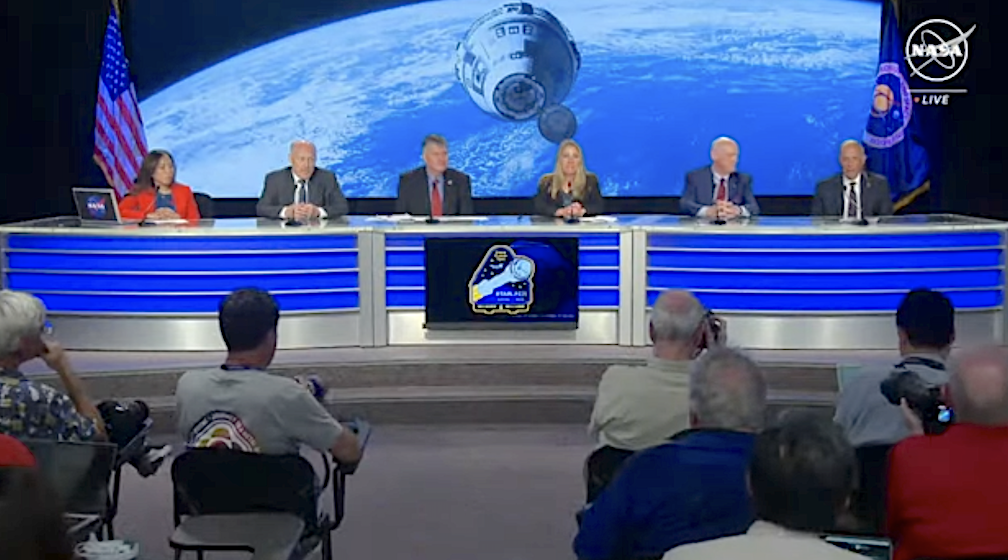
NASA’s Boeing Crew Flight Test now is targeted to launch no earlier than 6:16 p.m. EDT Friday, May 17, to the International Space Station. Following a thorough data review completed on Tuesday, United Launch Alliance decided to remove and replace a pressure regulation valve on the liquid oxygen tank on the Atlas V rocket’s Centaur upper stage.
ULA plans to roll the rocket, with Boeing’s Starliner spacecraft, back to its Vertical Integration Facility on Wednesday, May 8, to begin the replacement. The ULA team will perform leak checks and functional checkouts in support of the next launch attempt.
The oscillating behavior of the valve during prelaunch operations ultimately resulted in mission teams calling a launch scrub on May 6. After the ground and flight crew safely egressed from Space Launch Complex-41 (SLC-41) last night, the ULA team successfully commanded the valve closed and the oscillations were temporarily dampened. The oscillations then re-occurred twice during fuel removal operations. After evaluating the valve history, data signatures from the launch attempt, and assessing the risks relative to continued use, the ULA team determined the valve exceeded its qualification and mission managers agreed to remove and replace the valve.
Mission managers discussed the details leading to the decision to scrub the May 6 launch opportunity during a news conference shortly after the call at NASA’s Kennedy Space Center in Florida.
NASA astronauts Butch Wilmore and Suni Williams will remain at crew quarters in health stabilization until the next launch opportunity. The duo will be the first to launch aboard Starliner to the space station as part of the agency’s Commercial Crew Program.
May 06 21:59
Atlas V CFT scrub statement
Out of an abundance of caution for the safety of the flight and pad crew, we scrubbed the Crew Flight Test (CFT) launch attempt today due to an observation on a liquid oxygen self-regulating solenoid relief valve on the Centaur upper stage. The team needs additional time to complete a full assessment, so we are targeting the next launch attempt no earlier than Friday, May 10.

Pilot ingress. Now boarding Starliner is CFT mission pilot Suni Williams, a retired U.S. Navy captain and veteran of two previous spaceflights as a long-duration resident aboard the space station. Williams is from Needham, Massachusetts, and earned a physical science degree from the U.S. Naval Academy and a master’s in engineering management from the Florida Institute of Technology. She is married and is a dog mom.
ULA’s Launch director Tom Heter III has scrubbed tonight’s Starliner launch. Out of an abundance of caution for the safety of the flight and pad crew, we scrubbed the Crew Flight Test (CFT) launch attempt today due to an observation on a liquid oxygen self-regulating solenoid relief valve on the Centaur upper stage. The team needs additional time to complete a full assessment, so we are targeting the next launch attempt no earlier than Friday, May 10.
Starliner’s history has numerous scrubs. Boeing launched an orbital test flight without astronauts twice because of a botched first attempt in 2019 that failed to reach the ISS. They were also set to launch Williams and Wilmore last summer, but Boeing managers revealed new issues with the spacecraft after further examining data from Starliner’s OFT orbital flight test in May 2022.

The launch was halted due to an issue that cropped up with a valve on the spacecraft’s rocket two hours before launch. Mission controllers declared a launch “scrub” after an anomaly was detected on an oxygen valve on United Launch Alliance’s Atlas V rocket
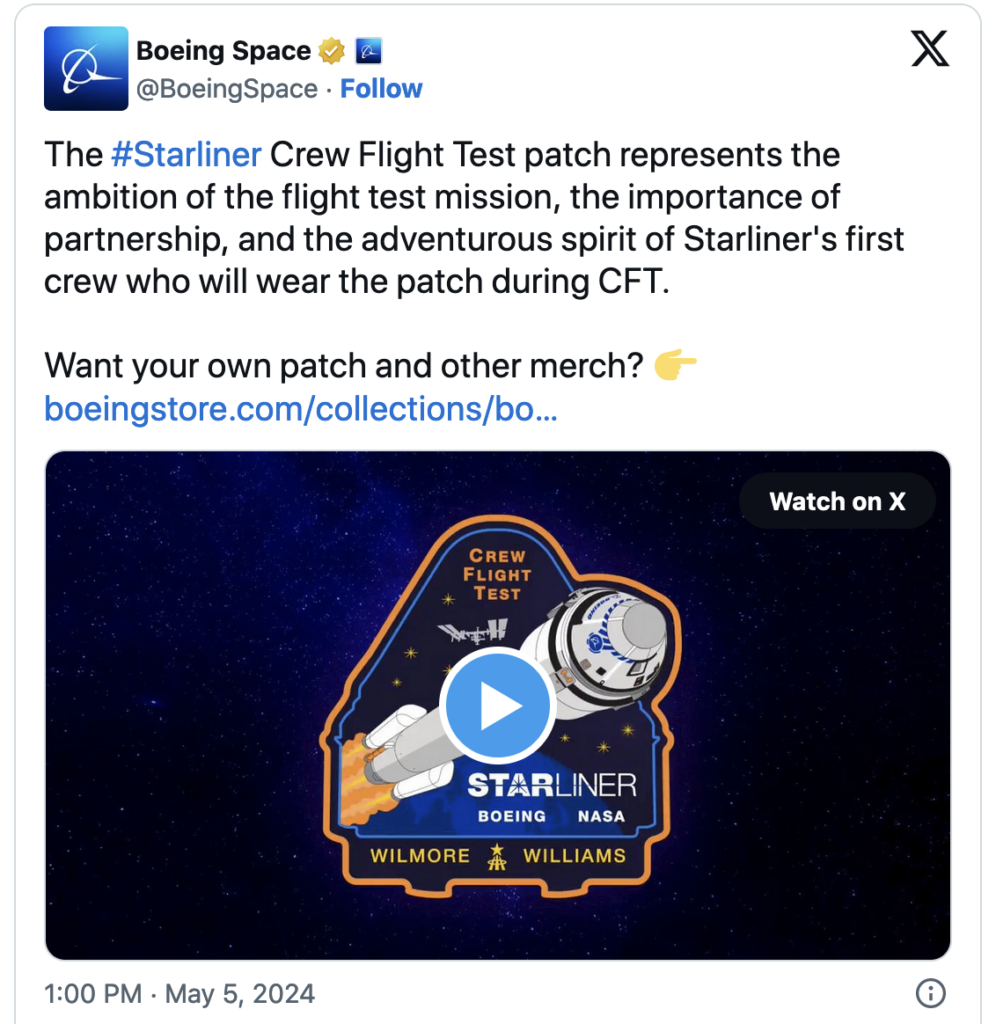
A new launch date has not yet been announced.
NASA’s Wilmore and Williams ready for ‘a room with a view’ as ULA counts down to Starliner launch

The official crew portrait celebrates the astronauts of the CFT mission. Photo by NASA
Everything continues to progress towards the ULA Atlas V launch carrying the first crewed Boeing Starliner spacecraft for NASA’s Commercial Crew Program (CCP). The mission is planned to lift off on Monday, May 6 from Space Launch Complex-41 at Cape Canaveral Space Force Station in Florida. The launch is planned for 10:34 p.m. EDT. Today’s forecast shows a 95 percent chance of favorable weather conditions for launch.
Launch Forecast Summary:
Overall probability of violating weather constraints: 5%
Primary concerns: Cumulus Cloud Rule
Overall probability of violating weather constraints for 24-hour delay: 5%
Primary concern: None
Meet the astronauts

The names of Wilmore and Williams will soon join Glenn, Carpenter, Schirra and Cooper as pioneering astronauts to launch atop Atlas rockets from Cape Canaveral.
The first four Americans to orbit the Earth during NASA’s Project Mercury all rode early Atlas boosters to place their single-seat capsules into space. Now 60 years later, Boeing’s CST-100 Starliner spacecraft will launch astronauts using the latest generation of Atlas V rockets for NASA’s Commercial Crew Program.

On Feb. 20, 1962, the Atlas 109-D rocket launched John Glenn, the first American ever to circle the planet in space, and his Friendship 7 capsule. His three orbits made Glenn a national hero.
The Atlas 107-D rocket launched Scott Carpenter and Aurora 7 on May 24, 1962, to orbit the Earth three times. Sigma 7 and Walter Schirra were launched by Atlas 113-D on Oct. 3, 1962, to complete six orbits. And Atlas 130-D launched Faith 7 and Gordon Cooper on May 15, 1963 for a 34-hour voyage in orbit, completing the Mercury missions.
NASA astronauts Butch Wilmore and Suni Williams will be the first crew members to fly aboard Starliner on its Crew Flight Test (CFT). Wilmore and Williams, both Naval aviators, military test pilots and former commanders of the International Space Station, have worked closely with Boeing to develop the Starliner spacecraft and ULA on the features required to carry crew.
Atlas V will launch Starliner on its journey to rendezvous and dock with the space station, where the two astronauts will live and work for about a week before undocking and returning to Earth to land at a site in the Western U.S.
Wilmore, commander of the CFT mission, is a retired U.S. Navy captain and veteran of two previous spaceflights to the space station. Wilmore is from Mt. Juliet, Tennessee, and earned degrees from Tennessee Technological University in electrical engineering and the University of Tennessee in aviation systems. He is married with two daughters.

Photo by NASA
Wilmore has accumulated more than 8,000 flight hours and 663 carrier landings, all in tactical jet aircraft, and is a graduate of the United States Naval Test Pilot School. During his tenure as a fleet Naval officer and aviator, Wilmore completed four operational deployments, flying the A-7E and F/A 18 aircraft from the decks of the USS Forrestal, USS Kennedy, USS Enterprise and the USS Eisenhower aircraft carriers.
Selected as an astronaut by NASA in July 2000, Wilmore was assigned technical duties representing the Astronaut Office on all propulsion systems, including the space shuttle main engines, solid rocket motors and external tank, and also led the astronaut support team that traveled to NASA’s Kennedy Space Center, Florida, in support of launch and landing operations. To date Wilmore has logged 178 days in space and has 25 hours and 36 minutes of time on four spacewalks.
He completed his first flight as pilot of space shuttle Atlantis on STS-129, logging 11 days in space in November 2009. This was the 31st shuttle flight to the station. During the mission, the crew delivered two Express Logistics Carrier racks and about 30,000 pounds of replacement parts to maintain the station’s proper orientation in space.
Wilmore’s second flight was as a long-duration resident aboard the station. From September to November 2014, he served as flight engineer for Expedition 41 and then as commander of Expedition 42 from November 2014 to March 2015 totaling nearly six months in space. Wilmore performed three spacewalks to prepare for new international docking adapters and future U.S. commercial crew spacecraft. In addition, he completed a spacewalk to replace a failed voltage regulator. Wilmore and two Roscosmos cosmonauts launched to the space station in a Soyuz spacecraft from the Baikonur Cosmodrome in Kazakhstan and returned to Earth safely to touch down in Dzhezkazgan, Kazakhstan after the 167-day mission.
Williams, pilot of the CFT mission, is a retired U.S. Navy captain and veteran of two previous spaceflights as a long-duration resident aboard the space station. Williams is from Needham, Massachusetts, and earned a physical science degree from the U.S. Naval Academy, and a master’s in engineering management from the Florida Institute of Technology. She is married and is a dog mom.

Photo by NASA
Williams has accumulated 3,000 flight hours in over 30 different aircraft. She received her designation as a Basic Diving Officer and later was designated a Naval Aviator. Williams was selected for United States Naval Test Pilot School, and after graduation she was assigned to the Rotary Wing Aircraft Test Directorate as an H-46 Project Officer. She went back to the Naval Test Pilot School as an Instructor in the Rotary Wing Department and the school’s Safety Officer.
Selected as an astronaut by NASA in June 1998, Williams has spent a total of 322 days in space on two missions and accumulated 50 hours and 40 minutes of cumulative EVA time on 7 spacewalks. Williams worked with Roscosmos on its contribution to the space station and with the first Expedition crew. After her first flight, she served as Deputy Chief of the Astronaut Office. She then performed another long-duration mission that included serving as station commander.
Her first spaceflight was Expedition 14/15 from December 2006 to June 2007, launching on space shuttle Discovery’s STS-116 mission to reach the station. While onboard, Williams established a world record for females at the time with four spacewalks. She concluded her tour of duty by returning to Earth with shuttle Atlantis’ STS-117 flight.
Williams launched from the Baikonur Cosmodrome in Kazakhstan on a Soyuz with a Roscosmos cosmonaut and Japanese astronaut for Expedition 32/33 from July to November 2012. Williams spent 127 days in space conducting research and exploration aboard the orbiting laboratory. She performed three spacewalks to replace a component that relays power from the space station’s solar arrays to its systems and repaired an ammonia leak on a station radiator.
ULA launch is imminent as first crewed Boeing Starliner mission readies for ISS

ULA’s L-2 report states that everything continues to progress towards the ULA Atlas V launch carrying the first crewed Boeing Starliner spacecraft for NASA’s Commercial Crew Program (CCP).
The mission is planned to lift off on Monday, May 6 from Space Launch Complex-41 at Cape Canaveral Space Force Station in Florida. The launch is planned for 10:34 p.m. EDT. Today’s forecast shows a 95 percent chance of favorable weather conditions for launch.
Launch Forecast Summary:
Overall probability of violating weather constraints: 5%
Primary concerns: Cumulus Cloud Rule
Overall probability of violating weather constraints for 24-hour delay: 5%
Primary concern: None



Launch Broadcast
Live broadcast coverage of launch will begin at 6:30 p.m. EDT on May 6 and will be available on NASA TV.
ULA’s day L-4 update as first crewed Boeing Starliner ready to carry astronauts to ISS

An Atlas V N22 rocket will launch Boeing’s Starliner on CFT. Photo by United Launch Alliance
Everything continues to progress towards the ULA Atlas V launch carrying the first crewed Boeing Starliner spacecraft for NASA’s Commercial Crew Program (CCP). The mission is planned to lift off on Monday, May 6 from Space Launch Complex-41 at Cape Canaveral Space Force Station in Florida. The launch is planned for 10:34 p.m. EDT.
Launch visibility
Wondering if you can see the Atlas V launch? This visibility map shows when and where your best chances are to see the rocket as it lifts off Monday at 10:34 p.m. EDT (0234 UTC) from Cape Canaveral.

Today’s forecast shows a 90 percent chance of favorable weather conditions for launch.
Launch Forecast Summary:
Overall probability of violating weather constraints: 10%
Primary concerns: Detached Anvil
Overall probability of violating weather constraints for 24-hour delay: 10%
Primary concern: Detached Anvil
May 2, 2024
United Launch Alliance (ULA) uses a unique version of its Atlas V countdown for human spaceflight missions, in the name of safety, to complete hazardous fueling operations and then place the rocket in a quiescent state before the astronauts board.
Launch of the Crew Flight Test (CFT) is planned for May 6 at 10:34 p.m. EDT (0234 UTC) from Space Launch Complex-41 (SLC-41) at Cape Canaveral Space Force Station in Florida. A live countdown blog and launch webcast in collaboration with Boeing and NASA will be available on the ULA website.
The Atlas V launch countdown begins 11 hours and 20 minutes before liftoff and features a four-hour planned, built-in hold at the T-minus four-minute mark for crew ingress into Starliner.
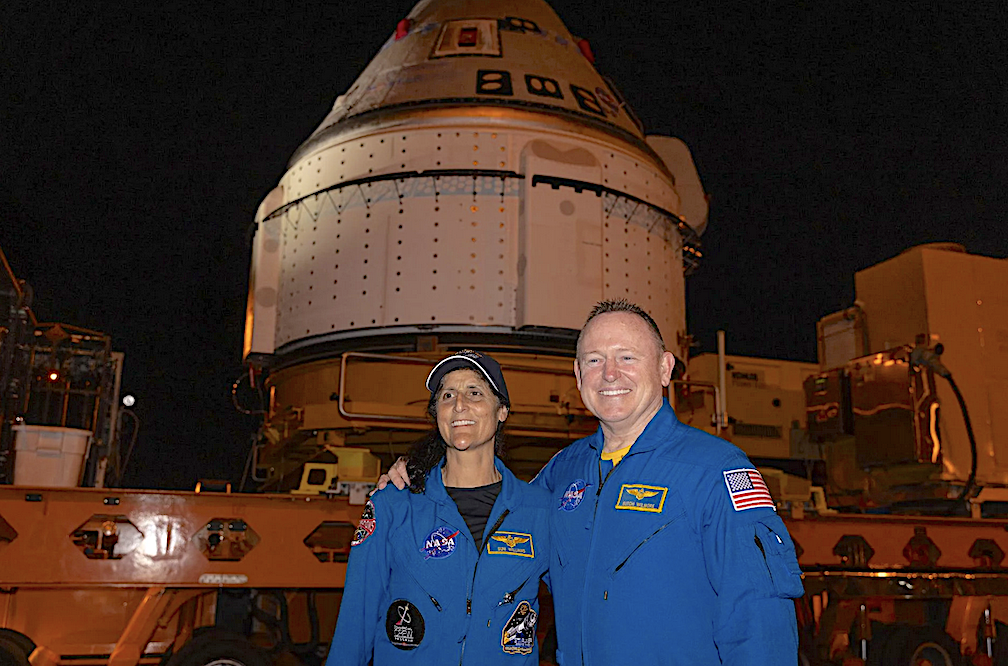
The CFT astronauts will board Starliner after Atlas V is readied. Photo by NASA
Overseeing the start of the countdown is the “Preps Team” of console operators inside the Advanced Spaceflight Operations Center. Launch Conductor Dillon Rice will orchestrate the countdown procedures from the Launch Control Center while ULA Launch Director James Whelan is at the helm in the Mission Director’s Center.
This initial phase of the count will be spent powering up the rocket, running system checkouts, completing standard pre-launch testing and performing final preparations on the rocket and pad systems for propellant-loading operations.
The Preps Team will lead the countdown through its first five hours, then a shift change occurs to hand each station to the “Tanking & Launch Team” of console operators. These counterparts take responsibilities for the next six hours through liftoff, led by ULA Chief Launch Conductor Doug Lebo and ULA Launch Director Tom Heter.
The shift handover happens during the planned, hour-long countdown hold at T-minus two hours. Just before the hold concludes, readiness polls are conducted to authorize the start of cryogenic tanking. With the pad cleared of all personnel, the hazardous operation of liquid oxygen and liquid hydrogen filling the Atlas V rocket’s stages for launch is performed.
Once fueling is completed and the rocket’s tanks placed into stable replenishment, the countdown enters the extended hold at T-minus four minutes. The Blue Team is dispatched to the pad’s 200-foot-tall (61-m) Crew Access Tower (CAT) to ready the White Room and Starliner crew module for arrival of the astronauts, assist the crew into their seats and then close the hatch for flight.
The team is comprised of eight specialists from ULA and Boeing. Dane Drefke, ULA’s mechanical operations lead engineer serves as the Blue Team Leader (BTL). He is in charge of the Blue Team’s activities and has an obligation to ensure everyone’s safety.
ULA’s three representatives on the Blue Team begin activities by walking across the 48-foot-long (14.6-m) retractable catwalk extending from the CAT to the White Room. Their duties include verifying the White Room is safe for personnel to enter, establishing access to the capsule, deploying the environmental seal between the pad and spacecraft and setting up access platforms.
The ULA members then switch places with five Boeing technicians, waiting in the wings on the CAT, led by Boeing’s Pad Team Leader Nate Keyek-Franssen for assisting the crew into the spacecraft.
The astronauts, commander Butch Wilmore and pilot Suni Williams, receive a final weather briefing and don their spacesuits before leaving NASA’s Crew Quarters in the Neil Armstrong Operations & Checkout Building at the Kennedy Space Center. Departure to board Boeing’s Crew Transport Vehicle (CTV) occurs about three hours and 20 minutes before launch.
The trip to SLC-41 will take about 25 minutes, with the CTV arriving at the base of the CAT approximately two hours and 55 minutes before launch. The astronauts will take the elevator to Level 12 while the CTV convoy departs the pad and heads to the safe fallback area.
Once crew ingress is completed, another weather briefing will be held 90 minutes before launch, to inform mission managers that conditions are suitable for the Blue Team to close the Starliner hatch and proceed with the countdown. Pending a go, Boeing technicians will close the hatch and perform cabin leak checks to verify the integrity of the seal.

The Crew Access Arm enables the astronauts to board the spacecraft. Photo by United Launch
AllianceBoeing personnel then depart the White Room so that the ULA technicians can retract access platforms and deflate the environmental seal around the spacecraft to prepare the Crew Access Arm for rotation to the launch position later in the countdown. The entire Blue Team departs the pad about 35 minutes before liftoff.
The access arm will be hydraulically swung away from the spacecraft 11 minutes prior to launch. The process will take about two minutes to reach the stowed position against the CAT. If the need arises, the arm can be redeployed in less than 15 seconds by dropping counterweights.
Seven minutes before launch, Lebo performs the readiness polling of the launch team members, Ascent Flight Director Mike Lammers in Houston and the Starliner crew before Heter gives final permission to launch. The countdown clocks resume four minutes before liftoff to put the rocket on internal power, pressurize its tanks, arm systems and start the main engine.
The daily available launch window is instantaneous, meaning there is only an instant in time each day for launch to occur. This split second happens when the orbital plane of the International Space Station passes over the launch pad, thereby enabling Atlas V to put Starliner on the proper trajectory to intercept the station for rendezvous and docking.
The main engine and twin solid rocket boosters generate 1.6 million pounds (7.1 mega-Newtons) of thrust to begin the voyage of Wilmore and Williams. The commander will call out “roll program” as Atlas V clears the tower to place the astronauts heads-up for their ride to space.
The main engine will ease back for a period of deep throttling, going into its throttle bucket during the region of maximum aerodynamic stresses on the rocket in the dense lower atmosphere and to lessen the G-loads on the crew.
The solid rocket boosters burn for a minute-and-a-half, followed by the main engine revving back to full throttle, to triple the rocket’s velocity through the remaining first stage of flight.
Just over two minutes after liftoff, Atlas V will have burned nearly 500,000 pounds (227,000 kg) of fuel and weigh only half of what it did at launch.

An illustration depicts Atlas V stagging during the launch of Starliner.
Following the first stage engine shutdown, the Atlas V common core booster will jettison from the Centaur four minutes and 35 seconds after liftoff. The Centaur ignites both engines 10 seconds later at an altitude of approximately 60 nautical miles (111 km).
The Centaur burn will last just over seven minutes to deliver Starliner at the desired injection point for separation at T+plus 14 minutes, 55 seconds into a 98 by 39-nautical mile (181×72-km) suborbital trajectory, inclined 51.6 degrees relative to the equator.
Atlas V will launch northeasterly from Cape Canaveral, paralleling the Eastern Seaboard and crossing the North Atlantic to accelerate Starliner to 17,475 mph (28,123 kmph).
For Starliner missions, Atlas V takes a special trajectory to space that requires the Centaur upper stage to use two engines instead of one. The double-engine configuration allows the rocket to fly a flatter trajectory and ensure the spacecraft can execute an abort at any time to bring the astronauts back to Earth safely if a problem occurs.
Dual Engine Centaur also enables the customized flight profile for Starliner that features just a single burn and a limited acceleration rate to manage the G-force experienced by the astronauts aboard.
After Centaur releases Starliner, the spacecraft employs the same operational procedure as the space shuttle, which also launched on suborbital trajectories, by performing an orbital-maneuvering engine firing to reach a stable orbit about 15 minutes after separation.
ULA’s Starliner in countdown mode and Status Check for first human launch of NASA astronauts Wilmore and Williams to ISS

Atlas V will launch Boeing’s Starliner with two NASA astronauts on the Crew Flight Test mission. Photo by United Launch Alliance

Wednesday was busy again with the responsibilities and plans for United Launch Alliance (ULA) Atlas V rocket’s launch on May 6, 2024 at 10:34 p.m. EDT Boeing’s Crew Space Transportation (CST)-100 Starliner spacecraft with two NASA astronauts, Barry “Butch” Wilmore and Sunita (Suni) Williams on the Crew Flight Test (CFT).
Following separation from Atlas V, Starliner engines will burn taking it the rest of the way to orbit and on to the International Space Station. CFT is ULA’s first human launch. Liftoff will occur from Space Launch Complex-41 at Cape Canaveral Space Force Station, Florida.
On the shoulders of Atlas, Boeing’s CST-100 Starliner spacecraft will soon launch two NASA astronauts on the Crew Test Flight (CFT) to the International Space Station for NASA’s Commercial Crew Program
United Launch Alliance (ULA) is readying the Atlas V rocket for the historic flight test that is targeted for launch on May 6 from Space Launch Complex-41 at Cape Canaveral Space Force Station in Florida.
Astronauts Butch Wilmore and Suni Williams will be the first crew members to fly aboard Starliner. Wilmore, the CFT commander, is a retired U.S. Navy captain and veteran of two previous spaceflights to the space station. Williams, serving as the CFT pilot, is also a retired Navy captain and veteran of two previous spaceflights as a long-duration resident aboard the orbiting laboratory.

Starliner arrives at the VIF. Photo by United Launch Alliance
This morning, Starliner traveled from Boeing’s Commercial Crew and Cargo Processing Facility (C3PF) at NASA’s Kennedy Space Center to ULA’s Vertical Integration Facility (VIF) for connection to the Atlas V.
ULA’s motorized payload transporter, adapted to carry Starliner, moved at a top speed of 5 mph, heading from the C3PF, a former space shuttle hangar, eastward to the beach and then southward to the launch site. The transporter deck also provided Starliner with environmental controls to keep its compartments in good health during the transport.
Approaching the VIF, the transporter maneuvered up to the 30-story-tall building’s doorway and parked. A four-point lifting sling, called the Handling Fixture Hoist Tool, was connected to the Starliner, for the overhead crane to carefully raise the spacecraft onto the Atlas V waiting inside the VIF aboard its Mobile Launch Platform (MLP).
Starliner was positioned for mating to the Launch Vehicle Adapter (LVA) that serves as the spacecraft’s cradle on the rocket during ascent. The LVA also features the aeroskirt structure that smooths the air over the combined payload and Atlas V for aerodynamic stability.
Next up is the integrated systems test, a tip-to-tail electrical check of the 172-foot-tall (52-meter) Atlas V and Starliner stack.

Atlas V and Starliner stand ready for CFT. Photo by United Launch Alliance
The MLP will move the rocket and spacecraft to the pad approximately two days prior to liftoff for final sequence of activities that include testing, fueling, boarding of the astronaut crew and launch.
Starliner is a next-generation, autonomous spacecraft for safe and reliable crew and cargo transportation to and from low-Earth orbit destinations. For NASA missions to the orbiting laboratory, Starliner will carry up to four NASA-sponsored crew members and about 220 pounds of time-critical scientific research.
CFT will reuse the Starliner crew module that flew the first OFT mission, named Calypso by Williams.
Following a successful CFT mission, NASA will begin the final process of certifying the Starliner spacecraft and systems for crew missions to the space station. Long-duration commercial crew rotation missions enable NASA to continue the important research and technology investigations taking place aboard the orbiting laboratory. Such research benefits people on Earth and lays the groundwork for future space exploration.
Update to ULA’s Starliner’s first human launch of NASA astronauts Wilmore and Williams to ISS

Launch Vehicle on Stand: Atlas V Starliner Crew Flight Test
The United Launch Alliance (ULA) Atlas V booster arrives at the Vertical Integration Facility (VIF) adjacent to Space Launch Complex-41 at Cape Canaveral Space Force Station. The rocket will launch Boeing’s Starliner spacecraft on the Crew Flight Test (CFT) with NASA astronauts Butch Wilmore and Suni Williams to the International Space Station. Photo by United Launch Alliance
Daily routines and dress rehearsals keep everyone busy in preparation for the first launch of humans in an ULA Atlas V rocket to the ISS. Here’s a peek at some of the proceedings that are taking place in beautiful Florida and the weather is picture perfect.
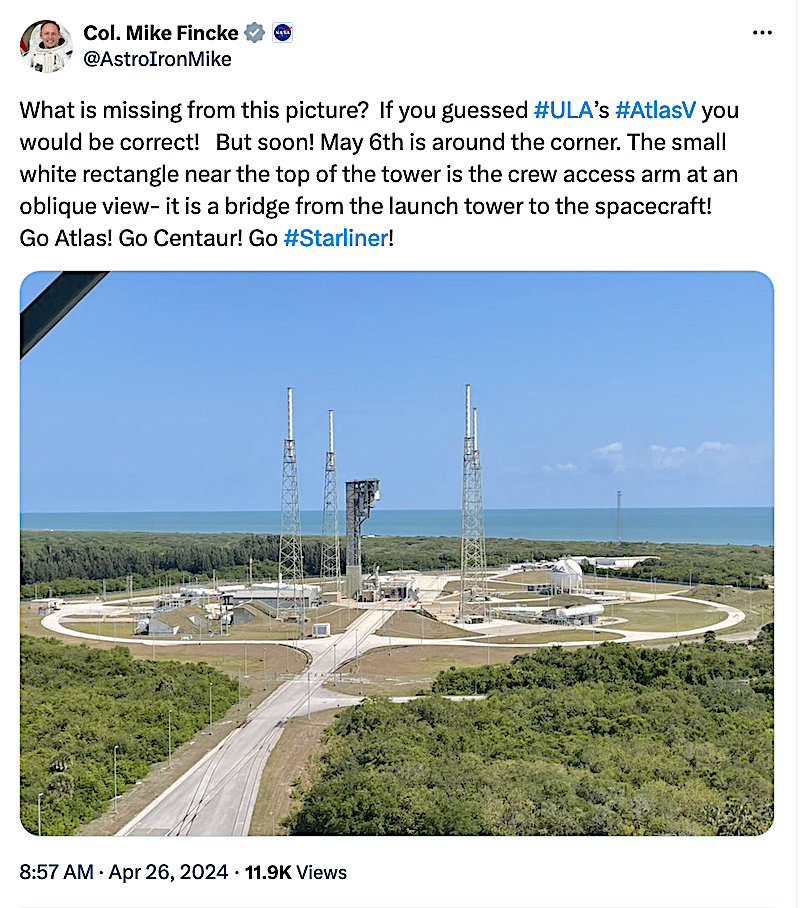
A United Launch Alliance (ULA) Atlas V rocket will launch on May 6, 2024 at 10:34 p.m. EDT Boeing’s Crew Space Transportation (CST)-100 Starliner spacecraft with two NASA astronauts, Barry “Butch” Wilmore and Sunita (Suni) Williams on the Crew Flight Test (CFT).


Ed Van Cise @ Carbon_Flight
A very successful mission dress rehearsal is complete! This was the last integrated training event before launch. I was fortunate to be able to observe the crew with @AstroIronMi while @Saturn_Flight led the MCC activities. Go #Starliner! Go CFT!

ULA’s Atlas V Starliner’s first human launch of NASA astronauts Wilmore and Williams to ISS

A United Launch Alliance (ULA) Atlas V rocket will launch on May 6, 2024 at 10:34 p.m. EDT Boeing’s Crew Space Transportation (CST)-100 Starliner spacecraft with two NASA astronauts, Barry “Butch” Wilmore and Sunita (Suni) Williams on the Crew Flight Test (CFT).
Following separation from Atlas V, Starliner engines will burn taking it the rest of the way to orbit and on to the International Space Station. CFT is ULA’s first human launch. Liftoff will occur from Space Launch Complex-41 at Cape Canaveral Space Force Station, Florida. Go Atlas! Go Centaur! Go Starliner!
Mission Overview
A United Launch Alliance (ULA) Atlas V rocket will launch Boeing’s Crew Space Transportation (CST)-100 Starliner spacecraft with two NASA astronauts on the Crew Flight Test (CFT). Following separation from Atlas V, Starliner engines will burn taking it the rest of the way to orbit and on to the International Space Station. CFT is ULA’s first human launch. Liftoff will occur from Space Launch Complex-41 at Cape Canaveral Space Force Station, Florida.
CFT is the final test to demonstrate the full end-of-end capabilities of the Starliner system to deliver crews to and from the space station as part of NASA’s Commercial Crew Program. The unique Atlas configuration for Starliner includes a dual-engine Centaur upper stage to deliver the performance needed to shape the trajectory for crew safety; a launch vehicle adapter that structurally attaches the Starliner to the Atlas V rocket for ascent; a 70-inch-long (1.8-m) aeroskirt to enhance the aerodynamic characteristics, stability and loads of the Atlas V; and an Emergency Detection System that provides an extra layer of safety for astronauts riding the reliable Atlas V. The Atlas V Starliner launch countdown features a four-hour planned, built-in hold at the T-minus 4-minute mark. This allows the rocket to be fueled and placed in a quiescent state before boarding of the astronauts into the spacecraft.
CFT bridges the history of Atlas with today’s rocket. The first orbital spaceflights of American astronauts in the 1960s were launched in Project Mercury by Atlas rockets from Cape Canaveral. That legacy continues with Atlas V launching crews from U.S. soil.
Launch Vehicle
Spacecraft
Modified specifically for the Boeing CST-100 Starliner spacecraft, the Atlas V Starliner configuration does not include a payload fairing. Instead, the Starliner’s insulated surfaces take the place of the fairing to protect the uncrewed spacecraft during ascent. The vehicle’s height with the Boeing CST-100 Starliner is approximately 172 ft (52.4 meters).
The CST-100 Starliner is attached to the Atlas V using a launch vehicle adapter (LVA), which also includes an aeroskirt to reduce the aerodynamic loads on the vehicle. The aeroskirt is jettisoned for improved performance following booster stage separation.
Centaur
The Centaur second stage is 10 ft (3 meters) in diameter and 41.5 ft (12.6 meters) in length. Its propellant tanks are pressure-stabilized and constructed of corrosion-resistant stainless steel. Centaur is a cryogenic vehicle, fueled with liquid hydrogen and liquid oxygen. The Atlas V configuration for this mission is powered by dual RL10A-4-2 engines, each producing 22,600 lbs (100.5 kilo-Newtons) of thrust. The cryogenic tanks are insulated with a combination of helium-purged blankets, radiation shields and spray-on foam insulation (SOFI). The Centaur forward adapter (CFA) provides structural mountings for the fault-tolerant avionics system and electrical interfaces with the spacecraft. The Centaur also includes an Emergency Detection System (EDS) that monitors for critical hazards to detect an imminent or occurring failure. The EDS also provides critical in-flight data which supports jettison of the ascent cover and initiates CST-100 Starliner spacecraft separation.
Booster
The booster is 12.5 ft (3.81 meters) in diameter and 106.5 ft (32.4 meters) in length. The booster’s tanks are structurally rigid and constructed of isogrid aluminum barrels, spun-formed aluminum domes and intertank skirts. Booster propulsion is provided by the RD-180 engine system (a single engine with two thrust chambers). The RD-180 burns RP-1 (Rocket Propellant-1 or highly purified kerosene) and liquid oxygen and delivers 860,200 lbs (3.83 mega-Newtons) of thrust at sea level. Two solid rocket boosters (SRBs) generate the additional power required at liftoff, with each SRB providing 348,500 lbs (1.55 mega-Newtons) of thrust. The Centaur avionics system provides guidance, flight control and vehicle sequencing functions during the booster and Centaur phases of flight.
Flight Profile

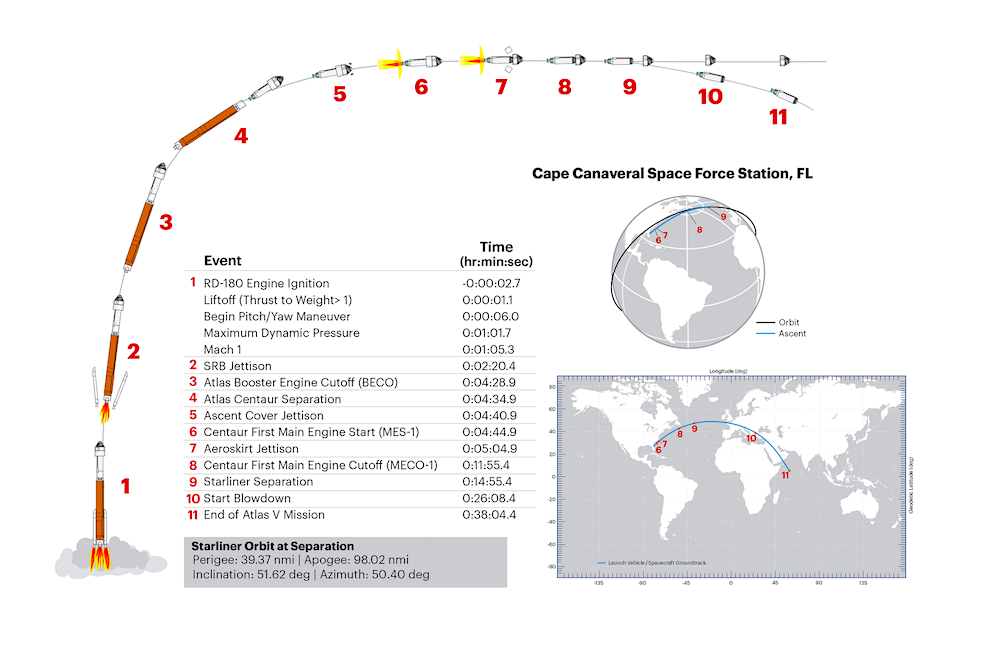
Space Launch Complex-41 // Processing

Space Launch Complex-41 (SLC-41), the East Coast home of the Atlas V rocket at Cape Canaveral Space Force Station in Florida, employs a “clean pad” concept of operations to ready launch vehicles and payloads for ascent into space. The rocket elements are assembled atop a Mobile Launch Platform inside the Vertical Integration Facility (VIF) located adjacent to the launch pad. The platform and fully stacked Atlas V then travel by rail approximately 1,800 feet northward from the VIF to the pad for the final countdown, fueling and liftoff. Complex 41 was constructed by the U.S. Air Force in the 1960s for the Titan rocket program. The site was rejuvenated in support of the Atlas V starting in the late 1990s.
1. Advanced Spaceflight Operations Center (ASOC)
Launch Control Center
Mission Director’s Center,
Mission Support Teams,
Launch Vehicle Horizontal Processing &
Ordnance Installation
2. Delta Operations Center (DOC)
ISA, Centaur, Boattail & Aeroskirt Vertical Integration
3. Vertical Integration Facility
Launch Vehicle Integration &
Testing, Spacecraft Mate &
Integrated Operations
Production

1. Sacramento, CA
Solid Rocket Booster Fabrication
at Aerojet Rocketdyne
2. Denver, CO
ULA Headquarters &
Design Center Engineering
3. Harlingen, TX
Booster Adapter &
Centaur Adapter Fabrication
4. Decatur, AL
Booster Fabrication & Final Assembly,
Centaur Tank Fabrication & Final Assembly
5. West Palm Beach, FL
RL10A-4-2 Engine Fabrication at
Aerojet Rocketdyne
6. Khimki, Russia
RD-180 Engine Fabrication at
NPO Energomash
